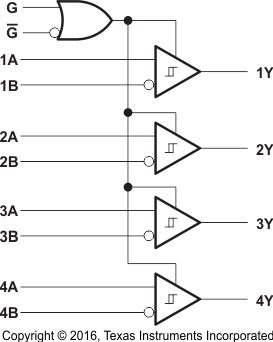JAJSCO6 November 2016 SN65LBC173A-EP
PRODUCTION DATA.
8 Detailed Description
8.1 Overview
The SN65LBC173A is a quadruple differential line receiver with tri-state outputs, designed for TIA/EIA-485 (RS-485), TIA/EIA-422 (RS-422), and ISO 8482 (Euro RS-485) applications. This device is optimized for balanced multipoint bus communication at data rates up to and exceeding 50 million bits per second. The transmission media may be twisted-pair cables, printed-circuit board traces, or backplanes. The ultimate rate and distance of data transfer is dependent upon the attenuation characteristics of the media and the noise coupling to the environment.
The receiver operates over a wide range of positive and negative common-mode input voltages, and features ESD protection to 6 kV, making it suitable for high-speed multipoint data transmission applications in harsh environments. These devices are designed using LinBiCMOS®, facilitating low-power consumption and robustness.
The G and G inputs provide enable control logic for either positive- or negative-logic enabling all four drivers. When disabled or powered off, the receiver inputs present a high-impedance to the bus for reduced system loading.
8.2 Functional Block Diagram

8.3 Feature Description
The device can be configured using the G and G logic inputs to select receiver output. The high voltage or logic 1 on the G pin allows the device to operate on an active-high, and having a low voltage or logic 0 on the G enables active low operation. These are simple ways to configure the logic to match that of the receiving or transmitting controller or microprocessor.
8.4 Device Functional Modes
The receivers implemented in these RS-485 device can be configured using the G and G logic pins to be enabled or disabled. This allows users to ignore or filter out transmissions as desired.
Table 1. Function Table(1)
| INPUT | ENABLES | OUTPUT | |
|---|---|---|---|
| A - B (VID) | G | G | Y |
| VID ≤ −0.2 V | H | X | L |
| X | L | ||
| −0.2 V < VID < -0.01 V | H | X | ? |
| X | L | ||
| −0.01 V ≤ VID | H | X | H |
| X | L | ||
| X | L | H | Z |
| OPEN | OPEN | ||
| Short circuit | H | X | H |
| X | L | ||
| Open circuit | H | X | H |